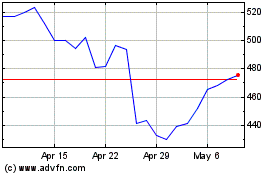By Nicole Nguyen
The same coronavirus post kept popping up on my Facebook feed
last week. People in my network -- a friend's mom, a college
classmate and another "friend," who I'm not sure I've even met in
person -- had somehow obtained identical symptom and treatment
guidance from Stanford University.
There were details about an at-home testing technique involving
breath holding, as well as something truly dubious about sipping
water every 15 minutes. On March 12, the university said the text
was "not from Stanford."
Overnight, the viral post disappeared from the social
network.
Then, last weekend, an urgent message circulated through group
chats. The text falsely suggested people stock up before a
soon-to-be-announced national quarantine. Please share with your
networks, the message pleaded. On Sunday night, the National
Security Council shot down the speculation on Twitter. "Text
message rumors of a national #quarantine are FAKE. There is no
national lockdown."
Many people spreading these fraudulent posts have good
intentions. Everyone's trying to keep up with an ever-shifting
situation. (Remember last week? That feels like years ago.) And
they want to help each other. But the current regularity of
forwarded falsehoods is revealing: Any absence of good information
leaves room for a lot of terrible information.
The World Health Organization recently described this moment as
an " infodemic." We're getting virus news through a fire hose --
push notifications, TV, social media, hearsay through our networks.
There's misleading or inaccurate information at every turn, despite
companies' efforts to remove it. And as social networks crack down
on misinformation, it's growing in grass-roots channels, like text
and email.
Many people, confused by all the noise, are still searching for
answers. So, how do we wade through the onslaught? I called some
experts for help.
Focus on factual information from official channels. "I would
strongly urge people to get their information from sources like the
Centers for Disease Control and Prevention or highly respected news
organizations. Everything else should be regarded as suspect," said
Angie Drobnic Holan, editor in chief of the Poynter Institute's
nonprofit fact-checking site PolitiFact.
In other words, focus more on facts from official sources, and
less on chasing down every shred that might be true, says Claire
Wardle, a research fellow at Harvard's Berkman Klein Center and
co-founder of First Draft, a nonprofit dedicated to studying
misinformation.
The more people are exposed to a falsehood, the more likely they
are to accept it as true -- what Dr. Wardle refers to as the
"familiarity backfire effect."
In that vein, my WSJ colleagues are regularly updating a guide
to what scientists and health officials know about coronavirus, as
well as answering readers' most pressing questions.
The primary sources that reporters rely on include the World
Health Organization and U.S.-based CDC. Both agencies provide virus
outbreak updates and guidance on how to stay healthy from public
officials. The CDC mobile app serves this information right to your
phone. Pro tip: Turn on the app's filter for "Coronavirus Disease
2019." The WHO launched a WhatsApp messaging service that provides
situation reports in real time, as well as information on
coronavirus myths. (If you are on your phone, this link takes you
right to the app to sign up.)
Many state and local authorities are also excellent resources,
Ms. Holan said. The CDC website includes links to every accredited
state and health department across the U.S.
The most-shared misinformation seems plausible. The most recent
wave of misinformation reads more like rumors that could be true or
are close to the truth rather than outright falsehoods, according
to Dr. Wardle. Fraudulent messages are often attributed to "a
friend of my friend who works in the government" or other
authoritative entities.
"A lot of this stuff is not malicious. It's people trying to
help each other, but it's false," she said.
Misinformation is moving from public to private channels. The
internet's largest social networks are aggressively moderating
coronavirus content. On March 16, Facebook, Google, LinkedIn,
Microsoft, Reddit, Twitter and YouTube sent a joint statement: "We
are ... jointly combating fraud and misinformation about the virus
[and] elevating authoritative content on our platforms."
The crackdown has unintended consequences. "People started
moving into spaces where they can't be tracked. The only thing
holding things together is people holding other people
accountable," said Dr. Wardle.
Encrypted messaging services, like WhatsApp, have struggled to
police misinformation sent through their systems. To maintain
users' privacy, the messages stay encrypted end to end, with no
server in the middle being able to read their contents. To mitigate
misinformation, moderators must be able to see the message's
contents. On Wednesday, WhatsApp launched a coronavirus website,
asking users to not forward a message if they aren't sure it's
true.
Apple's iMessage is end-to-end encrypted in a similar way, so
the company can't see the contents of a message to identify whether
it is misinformation or spam.
Pause before you share. "Misinformation tends to play on
people's fears, " said Ms. Holan. In other words, if you're feeling
strongly -- either you're scared or feel like there's an urgent
need to take action -- that might be a sign that the information is
dubious.
If people stopped sharing entirely and just relied on official
sources, we'd likely be better off, Dr. Wardle said. "It's like
washing our hands. We have to get into new habits about sharing
only what we know," she said.
Look up which outlets covered the news. As mentioned previously,
focus on the facts. But if you want to do your own homework, here's
how.
Before sharing information, do a quick search to see if other
outlets have reported the same thing, advised Jon Keegan, an
adjunct assistant professor at the Columbia University School of
Journalism. He is currently an investigative data journalist at The
Markup. (He's also a former Wall Street Journal visual
correspondent.)
Mr. Keegan suggested GroundNews, an app and website that shows
you how many outlets have covered top stories at a glance. The more
widely a story is covered, the more credible it likely is.
Most important, Mr. Keegan noted, look at the source named in
those outlets' reporting. If multiple reports link to the same
questionable story, instead of citing primary sources, be
skeptical. Ideally, the reporting would come from an official
channel or independently confirmed by multiple publications.
Still, the experts all agree: Verifying information yourself
isn't necessarily useful. Independent fact-checking websites do the
digging for you. PolitiFact's dedicated coronavirus hub is updated
with the most-shared information on the web. Each fact-check is
graded on its level of truthfulness and includes the sources
PolitiFact's reporters used to determine its veracity. The Federal
Communications Commission has a Covid-19 consumer warning website
that includes samples of robocall and text messages scams.
If someone does send you false information, be gentle. When
confronting That Person (you know who I'm talking about) in your
group chat, don't harshly correct them. "People shut down when you
do that or get angry," said Ms. Holan. She advised meeting them
where they are: "People are most sympathetic to outlets they like
and what they perceive to be their team."
Try sending someone corrective information from an outlet they
trust. If that's not available, there are always official sources
like the CDC. Google's advanced search can help with this. You can
narrow results for a query to a particular domain, like
"cdc.gov."
If you're stressed by the digital deluge, turn it off. If you
want to stay connected with official updates, there's a great
alternative to Twitter and TV: Sign up for your city's Covid-19
text alerts where available. San Francisco, Chicago, Seattle and
New York are among those that have a system in place.
Yep, you can mute it all -- the group texts, Twitter accounts,
Facebook friends, email and Slack. (Just don't ignore your boss!)
There is a lot of fear and uncertainty in this moment. Please take
care of yourself in all the ways you need, even if that means
virtually shutting up your uncle.
--For more WSJ Technology analysis, reviews, advice and
headlines,
sign up for our weekly newsletter
.
(END) Dow Jones Newswires
March 22, 2020 09:14 ET (13:14 GMT)
Copyright (c) 2020 Dow Jones & Company, Inc.
Meta Platforms (NASDAQ:META)
Historical Stock Chart
From Mar 2024 to Apr 2024

Meta Platforms (NASDAQ:META)
Historical Stock Chart
From Apr 2023 to Apr 2024
